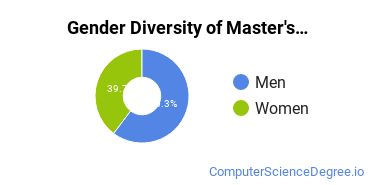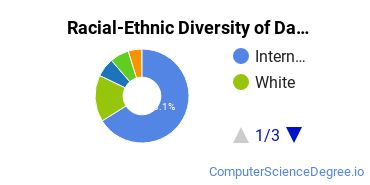Master’s Degrees in Data Processing
Featured schools near , edit
Education Levels of Data Processing Majors
In 2020-2021, 199 earned their master's degree in data processing. This makes it the 10th most popular master's degree program in the country.
The following table shows the number of diplomas awarded in data processing at each degree level.
| Education Level | Number of Grads |
|---|---|
| Associate Degree | 814 |
| Basic Certificate | 615 |
| Master’s Degree | 199 |
| Bachelor’s Degree | 170 |
| Undergraduate Certificate | 151 |
| Graduate Certificate | 4 |
| Doctor’s Degree | 2 |
Earnings of Data Processing Majors With Master’s Degrees
We are unable to calculate the median earnings for data processing majors with their master's degree due to lack of data.
Student Debt
The data on debt ranges for data processing majors who have their master's degree is not available.
Student Diversity
More men than women pursue master's degrees in data processing. About 60.3% of graduates in this field are male.
| Gender | Number of Grads |
|---|---|
| Men | 120 |
| Women | 79 |

The racial-ethnic distribution of data processing master’s degree students is as follows:
| Race/Ethnicity | Number of Grads |
|---|---|
| Asian | 31 |
| Black or African American | 8 |
| Hispanic or Latino | 11 |
| White | 27 |
| International Students | 111 |
| Other Races/Ethnicities | 11 |

Most Popular Data Processing Programs for Master’s Degrees
There are 7 colleges that offer a master’s degree in data processing. Learn more about the most popular 7 below:
The most popular school in the United States for data processing students seekinga master's degree is University of San Francisco. Roughly 10,000 attend the school each year. The average in-state tuition for full-time undergraduates is $52,920 per year, while in-state graduate students, on average, pay $27,180 per year. For the 2020-2021 academic year, 82 master's degrees were handed out to data processing majors at USFCA. Of these students, 45% were women and 23% were members of underrepresented racial-ethnic groups.
The 2nd most popular school in the country for data processing majors who are seeking their master's degree is Fordham University. Roughly 16,300 attend the school each year. The average in-state tuition for full-time undergraduates is $54,730 per year, while in-state graduate students, on average, pay $23,112 per year. During the 2020-2021 academic year, 49 people received their master's degree in data processing from Fordham U. Of these students, 33% were women and 16% were members of underrepresented racial-ethnic groups.
Boston University comes in at #3 on our list of the most popular colleges offering master's degrees in data processing. Each year, around 32,700 students seeking various degrees attend the university. The average in-state tuition for full-time undergraduates is $58,560 per year, while in-state graduate students, on average, pay $58,560 per year. The data processing program at Boston University awarded 36 master's degrees during the 2020-2021 school year. About 44% of this group were women, and 28% were students from an underrepresented racial-ethnic group.
The 4th most popular school in the country for data processing majors who are seeking their master's degree is Pratt Institute - Main. Each year, around 4,300 students seeking various degrees attend the university. The average in-state tuition for full-time undergraduates is $53,566 per year, while in-state graduate students, on average, pay $34,416 per year. For the 2020-2021 academic year, 11 master's degrees were handed out to data processing majors at Pratt Institute. Around 55% of these students were from an underrepresented racial-ethnic group, and 45% were women.
The 5th most popular school in the country for data processing majors who are seeking their master's degree is University of Nevada - Las Vegas. Roughly 31,100 attend the school each year. The average in-state tuition for full-time undergraduates is $7,949 per year, while in-state graduate students, on average, pay $5,823 per year. During the 2020-2021 academic year, 10 people received their master's degree in data processing from UNLV. Of these students, 30% were women and 40% were members of underrepresented racial-ethnic groups.
The 6th most popular school in the country for data processing majors who are seeking their master's degree is Northcentral University. Roughly 12,400 attend the school each year. The average in-state tuition for full-time undergraduates is $11,064 per year, while in-state graduate students, on average, pay $16,881 per year. During the 2020-2021 academic year, 9 people received their master's degree in data processing from Northcentral University. About 22% of this group were women, and 89% were students from an underrepresented racial-ethnic group.
George Washington University comes in at #7 on our list of the most popular colleges offering master's degrees in data processing. The average in-state tuition for full-time undergraduates is $57,894 per year, while in-state graduate students, on average, pay $32,850 per year. The data processing program at George Washington University awarded 2 master's degrees during the 2020-2021 school year.
Data Processing Focus Areas
| Major | Annual Degrees Awarded |
|---|---|
| Data Processing Technology | 199 |
Explore Major by State
Alabama
Arkansas
Connecticut
Florida
Idaho
Iowa
Louisiana
Massachusetts
Mississippi
Nebraska
New Jersey
North Carolina
Oklahoma
Rhode Island
Tennessee
Vermont
West Virginia
Related Majors
Below are some popular majors that are similar to data processing that offer master’s degrees.
| Major | Annual Degrees Awarded |
|---|---|
| Computer Information Systems | 18,992 |
| Computer Science | 14,364 |
| Information Science | 6,396 |
| Computer Software Applications | 3,555 |
| Computer Systems Analysis | 628 |
References
*The racial-ethnic minority student count is calculated by taking the total number of students and subtracting white students, international students, and students whose race/ethnicity was unknown. This number is then divided by the total number of students at the school to obtain the percentage of racial-ethnic minorities.
- College Factual
- National Center for Education Statistics
- O*NET Online
- Bureau of Labor Statistics
- Image Credit: By Kenneth Jensen under License
More about our data sources and methodologies.
Featured Schools
 Request Info
Request Info
|
Southern New Hampshire University You have goals. Southern New Hampshire University can help you get there. Whether you need a bachelor's degree to get into a career or want a master's degree to move up in your current career, SNHU has an online program for you. Find your degree from over 200 online programs. Learn More > |








